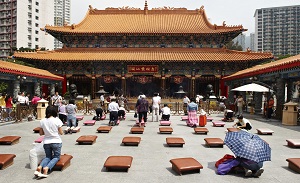Daoism in China Schools, Main Tenets, and the History of Practicing "The Tao"
 Daoism or 道教 (dào jiào) is one of the major religions indigenous to China. The core of Daoism is in learning and practicing “The Way” (Dao) which is the ultimate truth to the universe. Also known as Taoism, Daoism traces its roots to the 6th century BCE Chinese philosopher Laozi, who wrote the iconic book Dao De Jing on the tenets of the Dao.
Daoism or 道教 (dào jiào) is one of the major religions indigenous to China. The core of Daoism is in learning and practicing “The Way” (Dao) which is the ultimate truth to the universe. Also known as Taoism, Daoism traces its roots to the 6th century BCE Chinese philosopher Laozi, who wrote the iconic book Dao De Jing on the tenets of the Dao.
Laozi’s successor, Zhuangzi, further developed Daoist principles. Writing in the 4th century BCE, Zhuangzi recounted his famed “Butterfly Dream” transformational experience, where he dreamt he was a butterfly but upon awakening, posed the question “Was it the butterfly dreaming he was Zhuangzi?”
Daoism as a religion didn’t really flourish until hundreds of years later, around 100 CE, when Daoist hermit Zhang Daoling founded a sect of Daoism known as "The Way of the Celestial Matters." Through his teachings, Zhang and his successors codified many aspects of Daoism.
Conflicts With Buddhism
Daoism's popularity grew quickly from 200-700 CE, during which time more rituals and practices emerged. During this period, Daoism faced competition from the growing spread of Buddhism which came to China via traders and missionaries from India.
Unlike Buddhists, Daoists do not believe that life is suffering. Daoists believe that life is generally a happy experience but that it should be lived with balance and virtue. The two religions often came into conflict when both vied to become the official religion of the Imperial Court. Daoism did become the official religion during the Tang Dynasty (618-906 CE), but in later dynasties, it was supplanted by Buddhism. In the Mongol-led Yuan Dynasty (1279-1368) Daoists petitioned to gain favor with the Yuan court but lost after a series of debates with Buddhists held between 1258 and 1281. After the loss, the government burned many Daoists texts.
During the Cultural Revolution from 1966-1976, many Daoist temples were destroyed. Following economic reforms in the 1980's, many temples have been restored and the number of Daoists has grown. There are currently 25,000 Daoists priests and nuns in China and over 1,500 temples. Many ethnic minorities in China also practice Daoism. (see chart below)
Daoist Schools
Daoist beliefs have undergone a series of changes in its history. In the 2nd century CE, the Shangqing school of Daoism emerged focusing on meditation, breathing, and recitation of verses. This was the dominant practice of Daoism until about 1100 CE.
In the 5th century CE, the Lingbao school emerged which borrowed much from Buddhist teachings such as reincarnation and cosmology. The use of talismans and the practice of alchemy were also associated with the Lingbao school. This school of thought was eventually absorbed into the Shangqing school during the Tang Dynasty.
In the 6th century, Zhengyi Daoists, who also believed in protective talismans and rituals, emerged. Zhengyi Daoists performed offering rituals for showing thanks and the "Retreat Ritual" that includes repentance, recitations, and abstinence. This school of Daoism is still popular today.
Around 1254, Daoist priest Wang Chongyang developed the Quanzhen school of Daoism. This school of thought used meditation and breathing to promote longevity, many are also vegetarian. The Quanzhen school also further combines the three main Chinese teachings of Confucianism, Daoism, and Buddhism. Due to the influence of this school, by the late Song Dynasty (960-1279) many of the lines between Daoism and other religions were blurred. The Quanzhen school is also still prominent today.
Main Tenets of Daoism
The Dao: The ultimate truth is the Dao or The Way. The Dao has several meanings. It is the basis of all living things, it governs nature, and it is a method to live by. Daoists do not believe in extremes, instead focusing on the interdependence of things. Neither pure good or evil exists, and things are never completely negative or positive. The Yin-Yang symbol exemplifies this view. The black represents the Yin, while the white represents the Yang. Yin is also associated with weakness and passivity and Yang with strength and activity. The symbol shows that within the Yang there exists the Yin and vice versa. All nature is a balance between the two.
De: Another key component of Daoism is the De, which is the manifestation of the Dao in all things. De is defined as having virtue, morality, and integrity.
Immortality: Historically, the highest achievement of a Daoist is to achieve immortality through breathing, meditation, helping others and the use of elixirs. In early Daoist practices, priests experimented with minerals to find an elixir for immortality, laying the groundwork for ancient Chinese chemistry. One of these inventions was gunpowder, which was discovered by a Daoist priest who was searching for an elixir. Daoists believe that influential Daoists are transformed into immortals who help guide others.
Daoism Today
Daoism has influenced Chinese culture for over 2,000 years. Its practices have given birth to martial arts such as Tai Chi and Qigong. Healthy living such as practicing vegetarianism and exercise. And its texts have codified Chinese views on morality and behavior, regardless of religious affiliation.
Daoist Ethnic Minority Groups in China
| Ethnic Group: | Population: | Provincial Location: | More Info: |
| Mulam (also practice Buddhism) | 207,352 | Guangxi | About the Mulam |
| Maonan (also practice Polytheism) | 107,166 | Guangxi | About the Maonan |
| Primi or Pumi (also practice Lamaism) | 33,600 | Yunnani | About the Primi |
| Jing or Gin (also practice Buddhism) | 22,517 | Guangxi | About the Jing |
By Lisa Chiu
Suorce: learnreligions.com/

